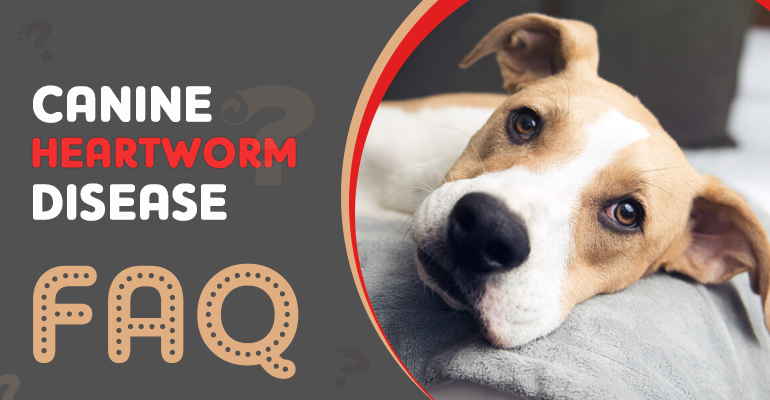Canine Heartworm Disease – FAQ
Dogs don’t deserve the kind of trouble heartworms bring into their lives. It’s one of those diseases that hides for months, sometimes years, before the signs really show up. By then, the damage is already sitting deep inside the lungs and heart, and the treatment is not a walk in the park either. The strange part? All of it can actually be prevented with a bit of routine care.
Heartworm in dogs isn’t some rare condition only a handful of unlucky pets get. It’s out there, riding around with every mosquito bite. That’s how sneaky this thing is.
The good news? There’s a lot known about how it works, how it spreads, and how to stop it before it even starts. The not-so-good news? Too many pet parents underestimate it until it’s too late. This piece breaks down the common questions that float in every dog parent’s head about heartworms.
What exactly are heartworms?
Heartworms are, honestly, about as gross as they sound. Picture spaghetti noodles, but inside a dog’s bloodstream. Long, thin worms that decide your dog’s heart and lungs are their forever home. And the scary part? You don’t see them. No signs in the poop, no crawling on the skin. They hide deep inside, slowly making life harder for the heart and lungs with every month they stay. By the time they grow into adults, they’re not just hanging out quietly, they’re causing real damage. Breathing becomes tougher, exercise feels impossible, and the dog just… slows down.
It’s not like other parasites, you can just treat quickly and move on. Once these worms settle in, it’s a whole different level of serious.
How do dogs even get heartworm?
The villain in this story isn’t the worm only, it’s the mosquito, too. The cycle goes like this: a mosquito bites an infected dog; it sucks up these microscopic baby worms floating in the blood (microfilariae). Then, when that same mosquito bites another dog? Boom. Infection spreads.
And because mosquitoes don’t care about your house being clean or your yard looking perfect, heartworm prevention for dogs has to be about protecting the dog directly. You can’t control every single mosquito. But you can stop the worms from ever getting a chance to grow inside your pup.
Can humans get it, too?
No. Pet parents are safe and can’t really get dog heartworm. Even if a mosquito bites both a dog and then you, it doesn’t work the same way in the human body. So, no cross-species issue here.
That said, this doesn’t mean it’s “not a big deal.” Just because humans are off the hook doesn’t mean dogs are. Too many pet parents shrug this off until it’s too late, and then they wish they hadn’t.
What are the first signs of heartworms in dogs?
Early on, your dog might look perfectly normal. You’d never guess anything’s wrong. But as the worms grow and start blocking up the blood vessels, the symptoms creep in.
- A soft, nagging cough that won’t quit.
- Getting tired after just a short walk.
- Breathing harder than usual, even while resting.
- Losing weight even if their appetite hasn’t changed.
The later stages? Much worse. Think fluid build-up in the belly, fainting, and sadly, sudden collapse. And by the time you see obvious signs, it’s usually already advanced. That’s why vets push prevention so much, because waiting for “signs” is waiting too long.
Find out More About : Early Signs of Heartworms in Dogs
What are the stages of heartworm disease in dogs?
Heartworms in dogs have four stages:
- Stage 1: No symptoms at all. The worms are there, but they’re just settling in.
- Stage 2: That cough starts. Dogs get tired quickly. You might think it’s just laziness or the weather.
- Stage 3: Now it’s obvious. Breathing issues, weight loss and weakness.
- Stage 4: The heart and lungs are under attack. Blood flow gets blocked. At this stage, survival is tough even with treatment.
The saddest part is that most guardians don’t notice until stage 2 or 3. And by then, the worms have already done a lot of harm.
Heartworm prevention for dogs
Heartworm prevention for dogs is literally a lifesaver here. Because treatment? It’s tough, expensive and risky. Prevention is simple.
Options come in different forms: chewable tablets, monthly spot-on treatments and even injections that last months. The point is the same: to stop the larvae before they can grow further.
Skipping doses is what messes things up. One “oops, I forgot this month” can open the door to infection. That’s why vets keep nagging about year-round prevention. Heartworm isn’t a seasonal problem. Mosquitoes show up when you least expect them, especially in warm climates.
So yes, monthly prevention isn’t just “extra care.” It’s essential.
Heartworm prevention vs. treatment for dogs
Heartworm treatment is no joke. It’s not just “give a pill and done.” Adult worms are killed using strong injections that put stress on the dog’s body. During this time, exercise has to be severely restricted. Even something as simple as running to the door can trigger complications because dying worms can block blood flow.
Not to mention that it’s expensive. Prevention costs way less compared to treatment, both in money and in stress. Prevention is like a seatbelt. Treatment is like surgery after the crash. Which would you pick?
Conclusion
Heartworm disease in dogs is not something to push to the back of the list. The worms don’t care if a dog looks healthy on the outside – once they settle in, they keep eating away at the lungs and heart quietly until the damage is permanent. Treatments exist, yes, but they’re expensive, painful, and scary for both pets and guardians. Prevention is so much cheaper, easier, and safer than waiting for the bad news.
If there’s one takeaway, it’s this: don’t gamble with missed doses or skipped tests. Mosquitoes aren’t going anywhere, and neither is the risk. A quick yearly blood test, sticking to prevention meds, and paying attention to early signs can literally save a dog’s life.
Because at the end of the day, every dog deserves more years chasing balls, begging for food, and curling up on the couch, not struggling to breathe because of something that could have been stopped.




